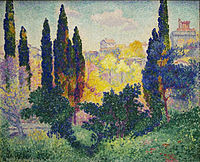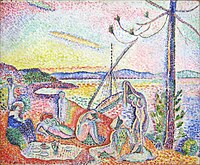Neo-Impressionism
| A Sunday Afternoon on the Island of La Grande Jatte | |
|---|---|
 | |
| Artist | Georges Seurat |
| Year | 1884–1886 |
| Type | Oil on canvas |
| Dimensions | 207.6 cm × 308 cm (81.7 in × 121.3 in) |
| Location | Art Institute of Chicago, Chicago |
Neo-impressionism is a term coined by French art critic Félix Fénéon in 1886 to describe an art movement founded by Georges Seurat. Seurat’s greatest masterpiece, A Sunday Afternoon on the Island of La Grande Jatte, marked the beginning of this movement when it first made its appearance at an exhibition of the Société des Artistes Indépendants (Salon des Indépendants) in Paris.[1] Around this time, the peak of France’s modern era emerged and many painters were in search of new methods. Followers of neo-impressionism, in particular, were drawn to modern urban scenes as well as landscapes and seashores. Science-based interpretation of lines and colors influenced neo-impressionists’ characterization of their own contemporary art.[2] Pointillism technique is often mentioned, because it was the dominant technique in the beginning.
Overview

Principles of Aesthetic: Light and Color
During the emergence of neo-impressionism, Seurat and his followers strove to refine the impulsive and intuitive artistic mannerisms of impressionism.[2] Neo-impressionists used disciplined networks of dots in their desire to instill a sense of organization and permanence.[3] In further defining the movement, Seurat incorporated the recent explanation of optic and color perceptions.
The development of color theory by Michel Eugène Chevreul and others by the late 19th century played a pivotal role in shaping the neo-impressionist style. Ogden Rood’s book, Modern Chromatics, with Applications to Art and Industry, acknowledged the different behaviors exhibited by colored light and colored pigment.[4] While the mixture of the former created a white or gray color, that of the latter produced a dark, murky color. As painters, neo-impressionists had to deal with colored pigments.[2] To avoid the dullness, they devised a system of pure-color juxtaposition. Mixing of colors was not necessary. The effective utilization of pointillism facilitated in eliciting a distinct luminous effect, and from a distance, the dots came together as a whole displaying maximum brilliance and conformity to actual light conditions.[3]
Origins of the term
There are a number of alternatives to the term, “neo-impressionism,” and each has its own nuance:
- Chromoluminarism was a term preferred by Georges Seurat.[2] It emphasized the studies of color and light which were central to his artistic style. This term is rarely used today.
- Divisionism, which is more commonly used, is often used interchangeably with the official term, “neo-impressionism.” It refers to the method of applying individual strokes of primary colors.[2]
- Neo-impressionism (new impressionism) Unlike other styles in this era, neo-impressionism did not receive its name by harsh critics that ridiculed its style.[2] Instead, the term embraces Seurat’s and his followers’ ideals in their style of art.
Note: Pointillism merely describes the technique of painting used during this period.
Criticism

At the start of the movement, neo-Impressionism was not welcomed by the art world and the general public. In 1886, when Seurat first exhibited his now most famous work, A Sunday Afternoon on the Island of La Grande Jatte, there was an overwhelming effect of negative feelings. The commotion evoked by this artwork could only be described with words like "bedlam" and "scandal".[2]
Neo-Impressionists’ use of tiny dots to compose a whole picture was considered even more controversial than its preceding movement, impressionism. Impressionism had been notorious for its spontaneous representation of fleeting moments and roughness in brushwork.[4] Neo-impressionism provoked similar responses for opposite reasons. The meticulously calculated regularity of brush strokes was deemed to be too mechanical.[5] This style of painting was far from the commonly accepted notions of creative processes set for the nineteenth century.
List of neo-impressionists
The Group of Néo-Impressionist Painters
Neo-Impressionism was first presented to the public, in 1886, at the Salon des Indépendants. The Indépendants remained their main exhibition space for decades with Signac acting as president of the association. But with the success of Neo-Impressionism, its fame spread quickly. In 1886, Seurat and Signac were invited to exhibit in the 8th and final Impressionist exhibition, later with Les XX and La Libre Esthétique in Brussels.
Finally, in 1892, a group of Néo-Impressionist Painters united to show their works in Paris, "in the Salons of the Hôtel Brébant, 32, boulevard Poissonnière." The following year they exhibited at "20, rue Laffitte". The exhibitions were accompanied by catalogues, the first with reference to the printer: Imp. Vve Monnom, Brussels; the second refers to "M. Moline", secretary.
2 December 1892 – 8 January 1893
- Participants: Alexandre Charpentier, Henri-Edmond Cross, Léo Gausson, Maximilien Luce, Hippolyte Petitjean, Lucien Pissarro, the late Georges Seurat, Paul Signac, Théo van Rysselberghe
December 1893, January 1894
- Participants: Charles Angrand, Henri-Edmond Cross, Maximilien Luce, Hippolyte Petitjean, Lucien Pissarro, Georges Pissarro, Félix Pissarro, Antoine de la Rochefoucauld, the late Georges Seurat, Paul Signac, Théo van Rysselberghe
Conclusion
This movement’s peak years lasted about five years (1886–1891), but did not end with Georges Seurat’s death in 1891.[3] Neo-impressionism continued to evolve and expand over the next decade with even more distinctive characteristics. Incorporation of political and social ideas, especially anarchism, started showing prominence.[1]
Neo-impressionist paintings
-
Charles Angrand, Couple dans la rue, 1887, oil on canvas, 38.5 x 33 cm, Musée d'Orsay, Paris
-
Théo van Rysselberghe, Portrait of Alice Sethe, 1888, Musée départemental Maurice Denis "The Priory", Saint-Germain-en-Laye
-
Camille Pissarro, Hay harvest at Eragny-sur-Epte, 1889, oil on canvas, 73 × 60 cm, private collection
-
Georges Lemmen, The Beach at Heist), 1891, oil on panel, 37.5 x 45.7 cm, Musée d'Orsay, Paris
-
Henri-Edmond Cross, Les cyprès à Cagnes, 1908, oil on canvas, 81 x 100 cm, Musée d'Orsay, Paris
-
Robert Antoine Pinchon, La Seine à Rouen au crépuscule, 1905, oil on paperboard, 65 x 54 cm, private collection
-
Jean Metzinger, Femme au Chapeau, c.1906, oil on canvas, 44.8 x 36.8 cm, Korban Art Foundation
-
Robert Delaunay, Portrait de Metzinger, 1906, oil on canvas, 55 x 43 cm
Timeline: Lives of the Neo-Impressionists
The Neo-Impressionists

See also
- Divisionism
- Pointillism
- Post-Impressionism
- Stippling
- Punctualism
- Micromontage, similar technique in music
References
- ^ a b Hutton, John G. (2004). Neo-impressionism and the Search for Solid Ground: Art, Science, and Anarchism in Fin-de-siecle France. Baton Rouge, Louisiana: Louisiana State University Press. ISBN 0-8071-1823-0.
- ^ a b c d e f g Lee, Ellen W.; Smith, Tracy E. (1983). Edelstein, Debra (ed.). The Aura of Neo-Impressionism: The W. J. Holliday Collection. Indianapolis, Indiana: Indianapolis Museum of Art, [dist. by] Indiana University Press. ISBN 0-936260-04-1.
- ^ a b c Fraquelli, Simonetta; Ginex, Giovanna; Greene, Vivien; Tosini, Aurora (2008). Radical Light: Italy’s divisionist painters, 1891–1910. London: National Gallery, [dist. by] Yale University Press. ISBN 978-1-85709-409-1.
- ^ a b Kleiner, Fred S.; Mamiya, Christin J. (2001). Gardner’s Art through the Ages (11th ed.). Thomson Learning, Inc. ISBN 0-15-507086-X.
- ^ Davies, Penelope J. E.; Simon, David L.; Hofrichter, Frima F.; Jacobs, Joseph F.; Roberts, Ann M. (2006). Jansen’s History of Art: The Western Tradition. Prentice Hall. ISBN 0-13-193455-4.
Further reading
- Floyd, Ratliff (1992). Paul Signac and Color in Neo-Impressionism. New York, New York: Rockefeller University Press. ISBN 0-87470-050-7.
- Herbert, Robert. Georges Seurat, 1859–1891, New York: Metropolitan Museum of Art, 1991. ISBN 9780870996184.
- Hutton, John G. (2004). Neo-impressionism and the Search for Solid Ground: Art, Science, and Anarchism in Fin-de-siecle France. Baton Rouge, Louisiana: Louisiana State University Press. ISBN 0-8071-1823-0.
- Ward, Martha (1996). Pissarro, Neo-impressionism and the Spaces of the Avante-Garde Chicago, Illinois: Chicago University Press. ISBN 0-226-87324-2.
- Haslett, Carrie (2002). Neo-impressionism: Artists on the Edge. Portland, Oregon: Portland Museum of Art. ISBN 0-916857-30-1.










